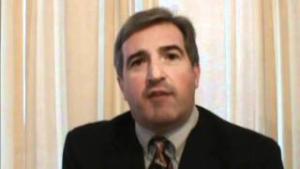Woman Walks After Prosecutorial Perfidy in Tucson [FEATURE]
Special to the Chronicle by Houston-based investigative journalist Clarence Walker, who can be reached at [email protected]. This article is the latest in his continuing series on prosecutorial misconduct in the war on drugs.
Aurora Lopez-Avila is back home in Mexico. A mother of three, she struggles daily to rebuild a shattered life that once hung in the balance -- after sitting for more than two years in a Tucson, Arizona, federal jail facing charges that she attempted to transport 10 kilos of cocaine across the Arizona-Mexico border on December 8, 2009.

But Lopez-Avila was freed this past May -- after Tucson-based federal Circuit Court Judge Cindy Jorgenson dismissed the drug charges because of blatant prosecutorial misconduct by Assistant US Attorney Jerry Albert during her trial last November.
Albert attempted to mislead the jury into convicting her by presenting a "falsified version" of questions that a federal magistrate judge had earlier asked Lopez-Avila, when she had originally pleaded guilty. The key question was whether she had been threatened to make her take the drugs across, but Albert instead made it seem as if the question was whether she had been threatened to make her plead guilty.
Informed of Albert's intentional act to undermine justice, Jorgenson declared a mistrial. And now a federal appeals court has demanded that Albert be investigated. It's another example of a "win at all costs" mentality that has infected federal prosecutors' offices across the land.
It went down like this:
In an effort to employ a duress defense, Lopez-Avila claimed during her trial that she had been forced to transport the drugs. To discredit her claim, Albert, a veteran narcotics prosecutor, attempted to show that her testimony contradicted what she said during an earlier magistrate's hearing. The court's written opinion showed that Albert intentionally presented to the court and counsel an altered version of the prior hearing's colloquy, making it seem as if the defendant had said that she had never been forced to smuggle the drugs she was charged with.
The 9th US Circuit of Appeals, which has jurisdiction over Arizona, was so angered over Albert's twisting the words of another judge that it has called for an investigation by the US Justice Department.
"In eight years as US Attorney and 26 years on the trial bench, this is the worst I've ever seen from an Assistant US Attorney," 9th Circuit Judge Donald Walter told the Arizona Star, adding that he was even surprised to hear that Albert was still working as a federal prosecutor.
Lopez-Avila first pleaded guilty in a bid to win a sentencing reduction, but later withdrew her plea.

When the federal probation officer tasked with conducting her pre-sentence investigation asked Lopez-Avila why she committed the offense and how much money she would receive, she suddenly broke down, sobbing uncontrollably. That's when she told the investigator and her attorney the truth of being coerced to transport the drugs. Speaking in Spanish, aided by translator, Lopez-Avila confessed she was "forced to drive the vehicle across the border and that she would make $1,500 for her misdeeds," Willimann explained.
Then she made a startling admission. "I thought I was carrying diet pills," Lopez-Avila told the officer and her attorney.
Assistant US Attorney Albert "got desperate thinking the government could lose the case because their own agent told the jury there was 'no evidence' that Ms. Lopez-Avila actually knew she had cocaine in the vehicle," Williman said. That assertion was made plausible by Lopez-Avila's statement that she actually thought she was carrying diet pills. While carrying diet pills across the border is also a crime, it is not the crime of cocaine trafficking.
To convince the jury to find Lopez-Avila "not guilty" due to being forced to commit the crime, Willimann had no choice but to have her testify in her own behalf to the fear she felt if she didn't comply with the mob boss order.
"My client previously pleaded guilty to the charges before Magistrate Judge Jennifer Zipps but subsequently she changed her plea to 'not guilty' and went to trial, Willimann explained.
She had an incentive to plead guilty early on. Under a provision of the federal sentencing guidelines known as "Acceptance of Responsibility," there is a benefit for defendants to admit guilt to prevent the government from wasting resources preparing for trial.
"When Ms. Lopez-Avila first pleaded without a plea agreement, we were vying for the extra level reduction under the provision, which is why I encouraged her to plead quickly," Williman explained. "At trial, Ms. Lopez-Avila's defense was the fact she was coerced by a drug boss to bring the drugs across the border and if she had not complied, her family would have been hurt."
If a jury had believed Lopez-Avila had been coerced, it was duty bound to follow the law and find her not guilty under the law of "duress." But to make sure he would undercut Lopez-Avila's "duress" defense, prosecutor Albert engaged in prosecutorial misconduct by violating the law to the point of "omitting the words" of the magistrate to undercut her testimony and convict her.
Albert's chosen tactic was the creative editing of the federal magistrate's earlier questioning. Reading from an altered transcript to carry out the "win at all cost" scheme, Albert asked Lopez-Avila if she remembered testifying at an earlier hearing. As Albert quoted the exchange of dialogue between Lopez-Avila and the magistrate, the magistrate asked, "Has anyone threatened you?"
"No," replied Lopez-Avila.
Reminding Lopez-Avila she had said she had not been threatened, Albert then turned to her and asked, "When you testified before the magistrate that you were not threatened in this case.... was that a lie?"
"Yes," said Lopez-Avila.
What Albert was attempting to do was to demonstrate to the jury that Lopez-Avila had lied on the stand when she testified she had been threatened into smuggling the drugs because her exchange with the magistrate when she originally pleaded guilty showed that she had not been threatened by drug traffickers.
But Alberts' creative editing of the magistrate's questioning and Lopez-Avila's answers misrepresented what had actually been said. What the magistrate had actually asked was, "Has anyone threatened you or forced you to plead guilty?"
"No," she replied.

Instead, Jorgenson found that a mistrial had occurred. "The court cannot cure the error by giving a jury instruction and I hereby grant the defense request to declare a mistrial," Jorgenson announced.
Willimann appealed Jorgenson's denial of his motion to dismiss the case against his client. Documented in the appeal was the prosecutor's illegal conduct surrounding Lopez-Avila's duress defense during trial.
In their brief to the 9th Circuit, Albert's colleagues conceded that his misquoting of the magistrate's words "had been intentional but claimed that the reading had been a fair one." But the judges on the panel weren't buying it.
"It is hard to see how a prosecutor could interpret a magistrate's question, 'Has anyone threatened you or forced you to plead guilty?' to mean 'Has anyone threatened you to commit this offense?" wrote Judge Carlos Bea.
Nor was the conservative jurist pleased with the revelation that the Southern Arizona US Attorney's Office was trying to make the "Albert affair" go away by requesting that the 9th Circuit remove Albert's name from their published opinion that criticized his unethical conduct.
"The effort by the Justice Department to conceal the name of its prosecutor, was in sharp contrast in announcing the accomplishments of its prosecutors in public," Bea noted. "The move reaffirmed the view of many lawyers that the Justice Department often acts reflexively in defense of its lawyers... and often resists efforts to hold abusive prosecutors accountable."
With the charges of prosecutorial misconduct deepening, Judge Jorgenson dismissed the charges against Lopez-Avila in May and issued a stinging rebuke not only to Albert, but to the entire Southern Arizona US Attorney's Office.
"This case is not simply about the mistake of one Assistant US Attorney, but rather the prosecuting office as a whole," Jorgenson wrote.
"I'm so grateful. Thank you very much," a jubilant Lopez-Avila told Williman in Spanish when the decision was issued before returning home to Mexico after her sojourn in the US criminal justice system.
Lopez-Avila was caught smuggling drugs. Her claim that she only did it because she was threatened by drug traffickers may or may not be true. We will never know because the case never made it to a verdict. The case never made it to a verdict because Assistant US Attorney Jerry Albert was so desperate for a win that he was willing to subvert the cause of justice.
The cogs of federal justice continue to grind in Tucson. The drug war provides plenty of fodder. And Jerry Albert remains on the job, at least for now -- the Justice Department's Office of Professional Responsibility is investigating.
"You Can't Stop AIDS Without Ending the Drug War" [FEATURE]
The XIX International AIDS Conference took place in Washington, DC, last week, bringing more than 20,000 scientists, activists, government officials, and journalists to assess the science and determine best practices for reducing the spread of the HIV virus. The US was able to host the conference for the first time in 22 years after it finally repealed a law denying people with HIV admission to the country.

Drug users and sex workers who wanted to attend the conference were thus faced with a dilemma: Tell the truth and be barred or lie on the visa application, which in itself is a violation of US immigration law. As a result, representatives of some of the groups most affected -- and most likely to be affected in the future -- were unable to attend.
"People do not want to run the risk of attending the conference in a country where they are told they are not wanted or desired," said Allan Clear, the executive director of the Harm Reduction Coalition. "It sends the message that people who have a history of drug use or sex work are not actually included in the dialog at all, and is a serious setback in the fight against AIDS. I don't think the US government has any particular interest in actually involving sex workers or drug users in policy or programming."
The exclusion of drug users and sex workers hasn't gone down well with activists. As far back as two years ago at the Vienna AIDS conference, Indian activist Meena Seshu called for a boycott of AIDS 2012, pointing out that it was unethical three decades into the AIDS epidemic to discuss AIDS policy without including those most affected. Some have boycotted the conference, opting instead to attend a Kiev conference that began July 9 for drug users and people living with HIV from Eastern Europe. Sex workers and their allies followed with a side meeting in Kolkata this week. While those two events are officially considered "hubs" of the International AIDS Conference, many attended them as a means of protesting the exclusion of drug users and sex workers in Washington.
Unhappiness broke into the open in Washington Monday when dozens of drug user and sex workers activists disrupted the conference's opening press event. They leapt from their seats unexpectedly and marched through the room, waving banners and shouting slogans such as "No drug users? No sex workers? No International AIDS conference!"
Discontent with AIDS policies that marginalize drug users and sex workers escaped from the conference rooms and onto the streets again on Tuesday, as hundreds marched to the White House chanting "No More Drug War" in a rally timed to coincide with the conference. The march broadened the scope of protest, linking the battle against AIDS with the war on drugs and corporate domination of US political life.
On the way to the White House, protestors stopped at UPS and Wells Fargo facilities to chide those corporations for unhelpful practices. UPS took heat for donating to politicians who voted to restore the federal ban on needle exchange funding, and Wells Fargo for investing in private prisons.
"Wells Fargo is literally invested in locking more people up," said Laura Thomas of Drug Policy Alliance (DPA).
Activism around drug users and AIDS also took place in the conference's Global Village, including the installation of a model of Vancouver's Insite supervised injection site and tours of a local needle exchange outreach van courtesy of DC's Family and Medical Counseling Services. The Harm Reduction and Global Drug Policy Zone in the village also featured special events and presentations put on by groups including the Harm Reduction Coalition, Harm Reduction International, the Hungarian Civil Liberties Union, the Eurasian Harm Reduction Network, and the International Network of People Who Use Drugs.
Advocates also took advantage of the AIDS conference to unleash a campaign on the theme of "You Can't End AIDS Unless You End the Drug War." Articles to that effect appeared on Alternet and the Huffington Post (and were picked up elsewhere), while Global Commission on Drug Policy member Richard Branson penned a USA Today op-ed piece on how drug prohibition contributes to the spread of HIV. As part of the same campaign, Politico ran a full-page ad signed by Global Commission members and other notables, repeating the message and directly challenging both President Obama and Gov. Romney to "do the right thing." Giants in AIDS advocacy like Michael Kazatchkine and Stephen Lewis joined the calls in speeches given during the conference.
In an unexpected cap to things, former President Bill Clinton called for drug use to be treated as a public health issue, not a criminal justice one, in remarks at the closing plenary. Clinton cited The Huffington Post and Alternet op-eds, coauthored by the Drug Policy Alliance's Ethan Nadelmann and American Foundation for AIDS Research founder Matthilde Krim.
Activists demanding a larger role for drug users and sex workers in setting the policies that are supposed to help them fight AIDS came armed with powerful ammunition. Two recent reports clearly lay out how criminalizing drug use helps spread the disease and how many countries are failing to adequately deal with the spread of HIV among injection drug users.
The first report, from the Global Commission on Drug Policy, makes its findings clear in its title: "The War on Drugs and HIV/AIDS: How Criminalization of Drug Use Fuels the Global Pandemic." In the report, the commission noted that injection drug use now accounts for one-third of new HIV infections outside of sub-Saharan Africa, including some 354,000 people in the US.
"Throughout the world, research has consistently shown that repressive drug law enforcement practices force drug users away from public health services and into hidden environments where HIV risk becomes markedly elevated," the commission said. "Mass incarceration of nonviolent drug offenders also plays a major role in spreading the pandemic."
The commission also remarked on "the remarkable failure" of drug prohibition in reducing the global drug supply. The worldwide supply of illicit opiates, such as heroin, has increased almost four-fold in recent decades, the commissioners noted. They also noted the drug war's contribution to the growth of organized crime and violence.
The commission identified proven addiction treatment and evidence-based public health measures that countries should put in place to reduce the spread of HIV and protect community health and safety. They include needle exchange programs, safer injecting facilities, and prescription heroin programs.
"Failure to take these steps is criminal," the commission said.
In the second report, "The Global State of Harm Reduction 2012: Towards an Integrated Response," from the London-based Harm Reduction International (formerly the International Harm Reduction Association), researchers found that while injection drug use has been identified in 158 countries, only half of them have any programs aimed at preventing the spread of HIV among injectors, and the situation internationally is not improving. Even in countries that are addressing the problem, programs suffer from lack of funding and donor support is decreasing. That is undermining the global response to AIDS, the report concluded.
"In the last two years, we have seen a significant scale-down of services in countries with some of the highest HIV burdens among people who inject drugs," said Rick Lines, the group's executive director. "As tens of thousands gather in Washington this week to call for an end to AIDS, it is becoming increasingly clear that governments have neither the will nor the intention of ending the spread of HIV among people who use drugs."
"We have seen the number of needle exchange programs in Russia drop for 70 in 2010 to only six in 2012. This is made worse by a retreat of many bilateral and multilateral donors to funding effective harm reduction interventions in many countries," said Claudia Stoicescu, public health analyst at Harm Reduction International and author of the report. "Such developments significantly limit progress toward global commitments to halve HIV transmission related to unsafe injecting by 2015, let alone any hope of achieving universal access to HIV prevention, treatment, care and support for people who inject drugs."
"The reluctance of governments to fund an adequate response to HIV and injecting drug use stands in stark contrast to the seemingly limitless budgets for ineffective and punitive law enforcement responses," said Lines. "Governments care more about fighting a losing war on drugs than they do about winning the fight against HIV."
As the world enters its fourth decade of living -- and dying -- with HIV/AIDS, this week's conference and its barriers to participation by and concern for some of those most directly affected by the crisis -- drug users and sex workers -- demonstrate how far we still have to go. They also make achingly clear the destructive role that drug prohibition and the criminalization of marginalized populations play in perpetuating the epidemic.
Maybe next time the International AIDS Society will hold its conference someplace where drug users and other marginalized groups can attend and be heard. Or maybe the United States will alter its harsh visa requirements aimed at drug users and sex workers. Either one would be good. Ending drug prohibition, the stigma it generates, and the obstacles to fighting disease it engenders would be better.
DOJ to Sentencing Commission: Fewer Prisoners, Please
In a congressionally mandated annual report to the US Sentencing Commission on the operation of federal sentencing guidelines, the US Department of Justice (DOJ) said continuing increases in the federal prison populations and spending are "unsustainable" and called on the commission to work with other stakeholders to reduce federal corrections costs. But the report failed to address the single largest factor driving the growth in the federal prison population: the huge increase in the number of federal prisoners doing time for drug offenses.

As DOJ noted in its letter, the first decade of that period corresponded to the end of decades of increases in crime and violent crime, leading to record high crime rates, which had generated a number of policy responses, including more police, harsher sentencing, and an increased emphasis on illegal drugs. But as DOJ also noted, beginning in 1992, violent crime has dropped consistently, and the US is now safer than it has been in decades.
All that costs money. The DOJ report noted that state, local, and federal criminal justice expenditures jumped nearly six-fold between 1984 and 2006, from $32.6 billion to $186.2 billion. State and local spending continued to rise until 2009, when the financial crisis and subsequent economic recession took hold, while federal criminal justice spending rose nearly ten-fold, from $4.5 billion to $41 billion.
But even though the federal government is more cosseted from economic hard time than the states, even it can no longer spend freely. As the DOJ letter noted, "The Budget Control Act of 2011 sent a clear signal that the steady growth in the budgets of the Department of Justice, other federal enforcement agencies, and the federal courts experienced over the past 15 years has come to an end."
While federal criminal justice budgets have been relatively flat in the last few years, the costs of imprisoning an ever-increasing number of people has not, and that means fewer resources for other criminal justice spending, including aid to state and local law enforcement and prevention and intervention programs. Within DOJ, the core law enforcement functions (policing, prosecution, prisons) have increased from 75% of the budget in 2002 to 91% this year.
"The question our country faces today is how can we continue to build on our success in combating crime and ensuring the fair and effective administration of justice in a time of limited criminal justice resources at all levels of government?" the DOJ noted. "In other words, how will the country ensure sufficient investments in public safety, and how will those involved in crime policy ensure that every dollar invested in public safety is spent in the most productive way possible?"
With budgets flat, criminal justice spending has to get more bang for the buck, the DOJ letter said.
"We must ensure that our federal sentencing and corrections system is strong but smart; credible, productive and just; and budgetarily sound," the letter said. "But maximizing public safety can be achieved without maximizing prison spending. The federal prison population -- and prison expenditures -- have been increasing for years. In this period of austerity, these increases are incompatible with a balanced crime policy and are unsustainable.
"We believe federal sentencing policy should be reviewed -- both systemically and on a crime-by-crime basis -- through the lens of public safety spending productivity. Adopting that perspective, we think it is clear that there are many areas of sentencing policy that call be improved," the letter continued. "We have identified many of the crime-specific areas over the last several years that warrant substantive reexamination. And we have also put forward legislative proposals to make systemic changes that would help control prison costs in a responsible way that furthers public safety. As to the guidelines process itself, we think reforms -- including some simplification of the guidelines and some limits on sentencing appeals -- are worth fully considering."
It is clear what is driving the growth in the federal prison population and the federal corrections budget: drug war prisoners. While the Obama administration DOJ is to be credited with taking some steps that move in the direction of reducing the number of prisoners and the corrections budget, such as supporting the partial reform of the crack/powder cocaine sentencing disparity, its failure to directly address the consequences of policies of mass imprisonment of drug offenders means that it is missing the elephant in the room.
Medical Marijuana Update
What!? No DEA raids? Not this week, but the federal crackdown on dispensaries continues, and cities and localities in medical marijuana states continue to grapple with the issues around it. Let's get to it:

Last Tuesday, 13 county attorneys urged Gov. Jan Brewer (R) to halt the state's medical marijuana program, citing fears that state employees could be charged with facilitating federal crimes when they issue licenses to dispensaries. They signed onto a letter authored by Yavapai County Attorney Sheila Polk, who requests that the governor prevent the state's issuance of licenses for medical-marijuana dispensaries because the state program is preempted by the federal Controlled Substances Act. Brewer responded two days later, saying she understands and shares the concerns of the prosecutors, but that she is bound to implement the law because voters approved it.
California
Last Tuesday, Sutter County supervisors rejected a proposed cultivation ordinance on a 3-2 vote. Supervisors said they had too many concerns about unintended consequences, including how it could be seen as the county giving tacit approval to marijuana growing. The ordinance would have limited outdoor grows to parcels at least 20 acres in size, with only 12 mature plants. Grows on fewer than 20 acres would have had to have been done indoors or in greenhouses.
Last Wednesday, the Solana Beach City Council voted to put a dispensary initiative on the November ballot. The initiative is similar to ones submitted by proponents in four other San Diego County cities -- Del Mar, Encinitas, Lemon Grove and La Mesa. Last week, Del Mar's council became the first of the four to agree to put the measure on the November ballot. It would create a set of regulations for medical marijuana dispensaries, including where they could locate and when they could be open. The operating hours would be limited to 8:00am to 10:00pm, and dispensaries couldn't locate within 600 feet of a school or a playground. If a prospective dispensary meets these restrictions, it could qualify for a city permit allowing it to open.
Last Thursday, a patient cooperative sued the city of Ventura after it was denied a business license to open a dispensary there. The Shangri La Care Cooperative filed a complaint in county superior court claiming the city has an "unwritten de facto ban on medical marijuana dispensaries" after the city denied its business license application last August, claiming "the request to open a medical marijuana dispensary does not appear to fall within any of the existing use types classified by the city’s zoning ordinance." But the location where Shangri La wants to open is zoned for medical and retail services. While the city says there is an administrative remedy -- applying for a conditional use permit -- Shangri La argues that it doesn't need a conditional use permit and that it doesn’t believe the city will grant one.
Last Friday, a Lake County judge indicated he would grant a temporary restraining order in a lawsuit challenging the county's marijuana cultivation urgency ordinance. Lake County Superior Court Judge David Herrick said the order would apply only to the plaintiffs in the case, which include Don Merrill and several other medical marijuana users identified as "Doe." Herrick will make a final determination on the order on August 15 after hearing additional arguments. The order would block the county from enforcing a 45-day urgency ordinance establishing regulations for marijuana growth, including where cultivation could occur and the number of plants allowed. That ordinance was passed July 9.
On Tuesday, San Diego activists hoaxed US Attorney Laura Duffy by issuing a statement purporting to be from her office in which she vowed to take her offensive against dispensaries to the next level by going after pharmacies. The fake news release used language similar to that used by Duffy in her campaign against dispensaries and fooled at least some local media outlets before the San Diego chapter of Americans for Safe Access revealed themselves as the authors of the prank. Duffy was not amused and is looking to see if any federal laws were violated.
Also on Tuesday, Butte County supervisors moved closer to an outdoor growing ban. The supes voted 3-2 to direct county staff to draft an ordinance similar to one in Kings County, which bans all outdoor cultivation of medical marijuana. The only medical marijuana growth allowed under the Kings County ordinance is for personal use by qualified patients within a locked and fully enclosed structure. County staff is expected to deliver the ordinance to the Board of Supervisors by the end of the month. The supervisors rejected an ordinance that would have allowed growers to cultivate between six and 99 mature marijuana plants based on the size of their plots.
Also on Tuesday, two San Francisco dispensaries closed their doors after threats from the feds. The Vapor Room and HopeNet both announced they would cease operations in response to threatening letters sent to the business' landlords by the federal government. Since November, the Justice Department has sent out 600 letters across California threatening landlords who rent space to medical marijuana operations. During that period, nine San Francisco dispensaries clubs have shut their doors, leaving the city with the lowest number of dispensaries in years.
On Wednesday, activists held a funeral march for the Vapor Room and Hope Net.
Colorado
Last Thursday, state officials released the most recent medical marijuana registry statistics. As of the end of May, there were nearly 99,000 registered patients in the state. The number peaked in July 2011 at nearly 129,000, but then dropped to under 81,000 by November as the feds turned up the heat on dispensaries in the state. The number has been slowing climbing again since then.
Maine
Last Thursday, health officials proposed new rules for the state's medical marijuana program. One key change would make optional a state identification system designed to keep track of patients who are enrolled in the program. The proposed new guidelines would also prevent police from seizing marijuana belonging to a patient, caregiver or dispensary unless the amount of the drug is over the legal limit for those groups or the seizure is linked to an ongoing criminal investigation.
Michigan
On Tuesday, the state Court of Appeals ruled that no Michigan municipality can use the federal Controlled Substances Act as an excuse to enact local ordinances that outlaw medical marijuana cannabis patients and caregivers from exercising their rights which currently exist under the Michigan Medical Marijuana Act. After the law was passed, several Detroit suburbs, including Livonia, Birmingham, Bloomfield Hills and Wyoming passed local ordinances barring patients from using medical marijuana in their communities and outlawing caregivers from operating within city boundaries. Now they've been told they can't do that. It's not clear whether they will appeal to the state Supreme Court.
Washington
On Monday, three Wenatchee-area dispensaries announced they had shut their doors after federal prosecutors sent threat letters to their landlords. The letter sent by Eastern Washington US Attorney Michael Ormsby threatened to seize the properties and threatened to fine or imprison the landlords if they did not close the shops within a few weeks. Three dispensaries closed immediately; a fourth is expected to close shortly.
Also on Monday, four collective employees were allowed to go into diversion programs after they were charged with marijuana possession and delivery for selling to patients at the Cannabis Outreach Service in Lacey and The Healing Center in Olympia. All four stipulated to selling marijuana, but if they complete the one-year program and avoid any subsequent criminal law violations, all felony charges against them will be dropped. All were initially charged with more than 20 felonies related to the possession, manufacture and distribution of marijuana. The charges came after the Thurston County Narcotics Task Force raided five medical marijuana collectives in Olympia on Nov. 15, including Cannabis Outreach Services and The Healing Center, and made 17 arrests. According to court papers, narcotics detectives obtained medical marijuana authorizations in their undercover names and purchased marijuana from all five of the medical marijuana collectives. Defendants from the three other Thurston County medical marijuana collectives still face pending criminal charges.
On Tuesday, the Tacoma City Council approved a collective cultivation ordinance that allows collective grows with some restrictions. It sets up a framework to abate, fine or otherwise crack down on those gardens that draw complaints or noticeably run afoul of a list of new restrictions. Among the new rules, the gardens can't operate within 600 feet -- about one city block -- of a school, daycare, drug rehabilitation center, park, library, or youth center. They also can't use signs to advertise the sale of cannabis; can't operate in the open; and can't permit entry to anyone under 18. Gardens that emanate noticeable odors into a public place or that have patients smoking marijuana in public also would be subject to city enforcement. The ordinance is harder on dispensaries; it defines them as public nuisances.
Medical Marijuana Rescheduling Lawsuit Moving
A decade after the Coalition for Rescheduling Cannabis (CRC) filed its petition seeking to have marijuana moved from Schedule I of the Controlled Substances Act, the federal courts will finally review the scientific evidence regarding the therapeutic efficacy of marijuana. The DC Circuit Court of Appeals announced late last week that it will hear oral arguments in October in a lawsuit filed by Americans for Safe Access (ASA) to force the government to act.

Under the Controlled Substances Act, Schedule I is reserved for drugs that "have a high potential for abuse, have no currently accepted medical use in treatment in the United States, and there is a lack of accepted safety for use of the drug or other substance under medical supervision."
Patient advocates charge the DEA and other federal agencies have ignored an increasing mountain of evidence on marijuana's therapeutic efficacy and that marijuana is "currently accepted [for] medical use in treatment" in 17 states and the District of Columbia. They also charge that the rescheduling process for marijuana has been "encumbered by politics" and that federal agencies are throwing roadblocks in the way of scientific research on medical marijuana.
"Medical marijuana patients are finally getting their day in court," said ASA chief counsel Joe Elford. "This is a rare opportunity for patients to confront politically motivated decision-making with scientific evidence of marijuana's medical efficacy. What's at stake in this case is nothing less than our country's scientific integrity and the imminent needs of millions of patients."
Oral arguments will take place Tuesday, October 16, at 9:30am at the E. Barrett Prettyman US Courthouse in downtown Washington.
Lebanon Hashish Eradication Hits New Obstacle
Last week, we reported on armed resistance against Lebanese government marijuana plant eradication teams in the Bekaa Valley, one of the world's leading hashish-producing regions. The country's Internal Security Forces (ISF) aren't having much easier going this week, though at least no one is shooting at them.

The bulldozer owners in the area are refusing to rent out their machinery for eradication operations out of fear they will be targeted by the marijuana growers. They pointed to skirmishes on the outskirts of Baalbek last week that left one policeman wounded and two police vehicles damaged. Of more direct concern to the bulldozer owners, 15 tractors were attacked during that incident, and the drivers said they were warned against participating in the crackdown.
ISF units accompanied by the Central Office of Drug Control and the Lebanese Army headed to Hermel to begin eradication there Tuesday morning, but had to abort the operation when the bulldozers failed to arrive. The Daily Star also reported that the forces on the ground decided to delay the operation "to avoid confrontations between prominent families in the area."
Lebanon is one of the world's leading hash producers, and the Bekaa Valley has long been known as a site of cannabis production. During the Lebanese civil war, the trade blossomed into a multi-billion dollar business, but after the war, the government banned it in 1992, and has undertaken eradication operations with varying degrees of enthusiasm each year since.
Farmers in the Bekaa say their area has been poor and marginalized for decades and that attempts to come up with substitute crops have been ineffective. Efforts to get farmers to switch to crops like sunflowers, saffron, and tobacco have not gone well, with the crops proving unsuitable for the environment and not as profitable as marijuana, and support for crop substitution programs has been inconsistent.
The eradicators have about another month to get at the sticky cash crop before Lebanese harvest season begins in earnest.
Colombian Coca Cultivation Ticks Upward
Coca cultivation in Colombia was on the rise again last year for the first time since 2007, according to the UN Office on Drugs and Crime's (UNODC) latest annual Colombia Survey. The survey, which is based on satellite and aerial surveillance photography, estimated that coca planting spread to 158,000 acres last year, up 3% over the previous year.

Despite the US assistance, Colombia has been unable to eliminate either the coca crop or the cocaine trade. Powerful armed groups, including the peasant guerrilla army of the FARC on the left and various paramilitary groups on the right, continue to profit from the trade while battling (or colluding with) the Colombian state.
UNODC also found that despite the increase in the area under cultivation, the amount of cocaine produced last year was 1% less than in 2010. Colombia produced 345 tons of cocaine last year, almost exactly as much as Peru did, leaving the two countries in a dead heat in the race to be named the world's number one cocaine producer. Bolivia was third.
The biggest increases in coca cultivation were in Putumayo and Caqueta departments near the border with Ecuador, where the FARC still maintains a strong presence. And more than 60% of cultivation is located in only four departments -- Narino, Putomayo, Guaviare, and Cauca -- where the FARC and the paramilitaries fight for control over crops and smuggling routes.
"That area has always been pretty ungoverned, it is basically wired for getting drugs out," said Adam Isacson of the Washington Office on Latin America. "The 2011 results make apparent that momentum toward reduced coca-growing has once again stalled," he told Reuters.
Handcuffed Marijuana Arrestee Shot, Killed in Police Car
A Southhaven, Mississippi, man arrested for marijuana by police in nearby Jonesboro, Arkansas, was shot and killed as he sat handcuffed in the back of a squad car Saturday. Chavis Carter, 21, becomes the 37th person to die in US domestic drug law enforcement operations so far this year.

Carter was sitting in the police car, and when police learned he had an outstanding warrant, Marsh had Carter "exit the patrol unit, placed him into handcuffs, searched him a second time then placed him into the back seat of the patrol unit."
As the two officers walked back toward the police car, Officer Baggett said a car passed and then he heard "a loud thump with a metallic sound." After questioning and releasing the other two men, Officer Marsh reportedly returned to his vehicle while Officer Baggett said he prepared to leave the scene. He then heard "several thumps" on his trunk and saw Officer Marsh motioning for him and saying that Carter had shot himself.
They opened the rear passenger door and found him in a "sitting position slumped forward with his head in his lap." According to Officer Marsh, Carter's hands were still cuffed behind his back and small-caliber handgun was found beside him.
Jonesboro Police Sgt. Lyle Waterworth told WREG-TV in nearby Memphis that Carter had been searched, but that searches don't always find everything. "As protocol he was handcuffed behind his back and double locked, and searched”, said Waterworth, "Any given officer has missed something on a search, be it drugs, knife, razor blades, this instance it happened to be a gun."
Officers Baggett and Marsh are on administrative leave pending an investigation, but the police are leaning toward the theory that Carter shot himself with a gun they had missed while his hands were cuffed behind his back.
His mother, Teresa Carter, isn't buying it. "I think they killed him, my son wasn't suicidal," she said.
She said Chavis had called his girlfriend while being pulled over to say that he would call her from jail. She also said police told her Chavis had been shot in the right temple, but that he was left-handed.
This Week's Corrupt Cops Stories
A crank-dealing Kansas sheriff cops a plea, an LA narc gets a case of sticky fingers, an Arkansas narc develops a fondness for dope, and a North Carolina parole officer gets caught forcing his parolees to supply him with drugs. Let's get to it:

In Stockton, Kansas, a former Rooks County sheriff pleaded guilty last Friday to four felony counts of distributing methamphetamine. Randy Axelson was the sheriff of Rooks County when he was arrested in December 2011 following an investigation by Kansas authorities. He was accused of distributing meth over a period of four months at the Rooks County Fairgrounds and within 1,000 feet of Stockton High School. Prosecutors dropped five counts in exchange for the guilty pleas and recommended that he serve five years and four months in prison. No sentencing date has yet been set.
In Rogersville, Arkansas, a former Hawkins County sheriff's narcotics detective pleaded guilty Monday to repeatedly burglarizing the department's evidence locker in March and April 2011 to steal drugs. Former Detective Brad Depew copped to 75 counts related to those burglaries and drug thefts -- as well as drug possession including 26 grams of cocaine, digital scales, a wide variety of pills, and a small amount of methamphetamine that was discovered during an April 21, 2011, search of his home. Prosecutors are recommending a 10-year prison sentence, but defense attorneys said the drugs were for his personal use -- not for sale -- and will seek judicial diversion. Narcotics found missing after one of Depew's evidence locker break-ins included 175 oxycodone pills, 79 grams of methadone, and 84.5 methadone pills from one specific criminal case. The defendant who those drugs were originally seized from pleaded guilty in March to reduced charges attributed directly to Depew's thefts.
In Asheville, North Carolina, a Western North Carolina prison official awaits sentencing on charges he extorted drugs from parolees under his supervision. James David Franklin, a surveillance officer for the North Carolina Department of Corrections, was originally arrested on drug trafficking charges for trying to sell 100 hydrocodone tablets in July 2010, but was indicted by a federal grand jury last August on four counts of extortion under color of official rights and one count of possession with intent to distribute drugs. Franklin copped a plea to two of the counts in December and had been free on bond until his judge revoked it in April. Franklin is accused of pressuring parolees to supply him with drugs, including methamphetamine and crack cocaine. He also provided hydrocodone to a parolee in exchange for cocaine. He went down after a parolee reported him to his federal probation officer and the feds set up a sting, which he walked right into, delivering 120 hydrocodone tablets to a mailbox in exchange for $375. His judge is considering a defense motion for a mental evaluation prior to sentencing. He's looking at up to 20 years in federal prison on the extortion charge.